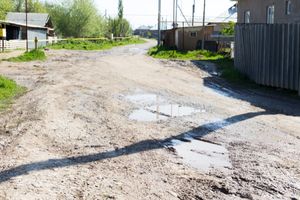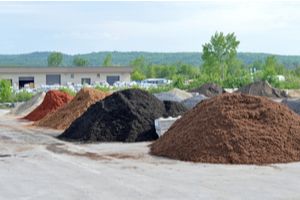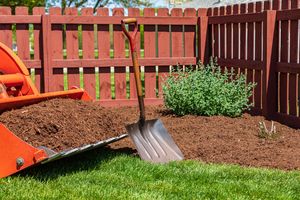When constructing homes, one of the goals is to ensure that rainwater falls away from the home’s roof and runs across the entire property instead of collecting around the house itself. Water only runs downhill, so any water that falls within 10 feet of the home in the form of rain or snowmelt needs a clear path away from it. Grading plays an important role in determining where the water on a property ends up and preventing it from damaging the home.
What Is Grading In Construction?
In construction, the term grading refers to the slope of the earth as it relates to the structure built on top of it. When there is a negative grade, it means that the earth slopes downward toward the structure. A positive grade, in contrast, means the slope is running downward from the structure.

A positive grade is desirable for homes as it keeps water away from the structure and allows the home to remain dry. A home that has a negative grade at any point along its perimeter can experience leaks and other types of damage.
Although grading is a major consideration when a home is being constructed, soil can settle over time and a home that once had perfectly graded soil surrounding it can find itself experiencing negative grade and the problems associated with it.
When grading an existing home, there are many considerations when it comes to determining the best ways to ensure water stays out. The type of soil used and the overall shape of the lot will play a big role in the overall success of the project.
What Soil Is Best For Grading Around A House?
Soil scientists generally refer to soil types in terms of their texture and composition, specifically the percentages of clay, silt and sand that are present. Understanding the type of soil at the home is important when determining the best approach to grading.
In the land surrounding many homes, the topsoil is typically porous to allow for planting grass and other landscaping and to absorb surface water well. Beneath this layer may be a sub-layer of clay or other non-porous soil to stop water from continuing to move downward and direct it laterally instead. If non-porous soil situated next to the foundation slopes inward toward the house, it can cause water to accumulate.

Expansive soil can lead to serious structural issues for the home’s foundation, and homes may settle or move if they are situated on unstable soil or the moisture level of their soil changes.
For grading, most types of fill dirt will work well as long as it is clean. Ideally, it will have a mix of salt and clay that is impermeable enough to divert water away, yet has enough gaps to avoid holding water against the structure. Some experts recommend screened topsoil taken from the pile at a local dirt supplier. Dirt that is a silty, clay loam will be easier to work with and more likely to settle into the semi-permeable state needed for grading, and it will also be more likely to support vegetation.
Soil Types To Avoid For Grading
Soils to avoid for grading are those that have a high content of clay or sand. Clay has a tendency to hold water against the wall of the foundation, while sand allows water to get through before draining and serves more as a filter.
Mulch is not recommended for increasing a grade as most mulches are too soft and absorb water without letting it run off. This means it will divert water downward toward the home or hold it against the foundation walls. Eventually, it will make its way through the walls and into the home and cause expensive damage.
Gravel and other porous materials are also not recommended because they are not good at providing a ramp or slope for water to travel down. Instead, water travels between the cracks of gravel to reach the earth below it.

For homes that have landscaping against them, black earthen manure mixes are considered acceptable soil for grading as long as local regulations are followed. Some homeowners choose river rocks and other landscaping rocks on account of their appearance, but they may be too porous and should be covered with a layer of silty clay soil for best results.
Another issue may arise with gardening mixes that have higher concentration of peat and similar materials. These are excellent at absorbing water, making them unsuitable for grading. One way of working around this is by keeping a one-foot buffer all around the home with a non-porous type of soil.
Lot Types
The type of lot that needs to be graded is another important consideration when it comes to choosing the right soil and equipment to get the job done successfully.
Sloped Lots
With a sloped lot, establishing the right grade is often easier and can be achieved with a smaller piece of earth-moving equipment such as a skid steer loader or a bobcat. For homes built on hillsides where the ground is sloping toward the house, a swale, or ditch, is used to slope the ground gently. This moves water away from the house while collecting water running downhill toward the home and directing it around a corner of the house so it can continue until the natural slope of the ground has fallen away from the structure.
Flat Lots
With a flat lot, things can be a bit more complicated. In some cases, the ground may be so flat that it is not possible to create a slope or swale. In this case, it may be necessary to pipe roof water as far away from the home as possible. A moat-like ditch can also be dug around the problematic areas of the home and filled with gravel to act as a collection area for surface water.
Reach Out To Dirt Connections
For assistance with grading projects of all sizes in the Northern Virginia area, get in touch with the team of experienced contractors at Dirt Connections today. From foundation excavation and water control to residential dirt grading, our experts can get the job done safely and effectively.
Summary

Dirt Connections was started with one goal in mind: providing quality residential and commercial construction services to clients on time and on budget. Reach out for more information on how we can support your next project.
For your convenience our estimates are free and by appointment. Call 703-940-9949 for a free estimate today!









































